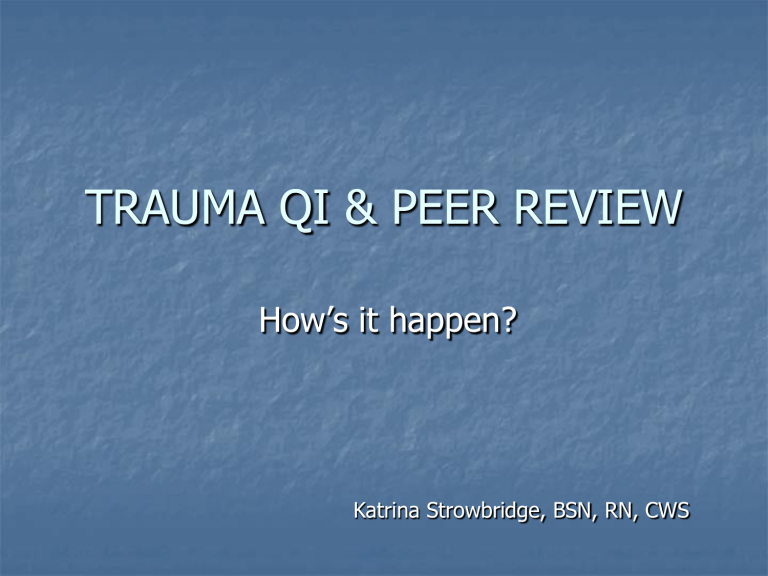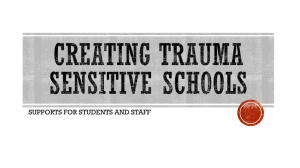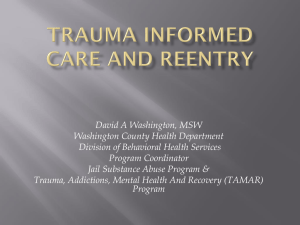TRAUMA QI & PEER REVIEW

TRAUMA QI & PEER REVIEW
How’s it happen?
Katrina Strowbridge, BSN, RN, CWS
Why a review process?
Trauma Designation
Organized trauma program required for all levels of designation to include:
Multidisciplinary trauma committee
Trauma Peer Review (with multidisciplinary committee)
Performance Improvement activities related to the findings of chart review and Peer Review
Whatsa
“Multidisciplinary Committee”???
RN’s
MD’s
Support Staff
Prehospital Providers
= Trauma
Committee
………..right?
that does peer review of charts …….
…..right?
Multidisciplinary Trauma
Committee is NOT the Medical Staff
Peer Review Committee
……so, how do ya do peer review of trauma cases
….
TRAUMA
COMMITTEE
PEER REVIEW
New Process
Case Selection for record review:
Record Selection via Daily Rounds
Trauma Coordinator gleans information from staff
Trauma Registrar review of ED log
ER charge review by RN
Chart identified by staff, physicians, department, etc
Meditech reports – ICD-9 diagnosis codes & discharge disposition
Focusing on:
Discharge Disposition
Treated and discharged home or transferred
Identified via daily review as described
If immediate concerns, reviewed by TC and
Trauma Medical Director/Chief of Staff
If no immediate concerns, coded by HIM
Record reviewed by TC and TR using a review worksheet.
Discharge Disposition cont.
Treated and Admitted to IP or OPO
Identified via daily reviews as described
Allows for concurrent review with more immediate documentation available in the form of progress notes, physician orders,
H&P, etc.
Immediate concerns reviewed with Trauma
Medical Director/Chief of Staff
Case identified, review begins
Trauma Committee Case Review
Worksheet
PI form used to abstract record
Indicators approved by Medical Staff & Trauma
Committee
Tracks key indicators used for QI processes
Developed from samples received from other CAH’s &
WRTAC sample forms.
Driving force for data collection of trauma related QI activities and documentation source for the review process.
Case Review “types” drive process
Primary Review
Secondary Review
Tertiary Review
Primary Review
Trauma Registrar
Initiates Trauma Committee Review form for each case reviewed
Forwards patient record and TCR form to Trauma
Coordinator
Trauma Coordinator
Review record, validates findings, finds new issues
Immediate resolution, feedback with identified issues & documentation of PI loop closure
Secondary Review
Trauma Coordinator reviews/validates findings, finds new issues
Medical Staff review of identified issues, supports investigation and assists in plan development
1:1 education (any discipline {RN: RN, MS: MS}, group education @ TC
May be closed at this level or forwarded for further action based on findings
Refer to Multidisciplinary Trauma Committee or
Medical Staff Peer Review Process
Tertiary Review
Trauma Coordinator & Medical Staff/Peer Review
WRTAC &/or STAC
Findings documented in PI loop closure
Education may still be 1:1, generally group @ large via Trauma Committee or regional efforts if required
Clinical Indicator Report
Trauma Registrar is responsible for completion of and reporting of data
Data pulled from Trauma Committee Case
Review form
Entered into Clinical Indicator Report
Clinical Indicator Report shared with Trauma
Committee
Used for ongoing monitoring
Identification of trends and issues
Peer Review
Confidential – confidential – confidential
– confidential – confidential – confidential
Peer Review Process
It is important that providers feel “safe” giving honest feedback to colleagues and this trust environment takes time to establish. The providers also need to feel empowered by Administration to tackle hard issues, require changed behaviors and performance of some peers and be able to hold colleagues accountable.
Trauma Committee
Peer Review Process
Trauma Coordinator is responsible for
setting up the Trauma Peer Review Committee meetings, obtaining the charts,
Keeping the Trauma Committee Case review form with the chart and initiating peer review form, engaging in discussion regarding any issues, transcribing the confidential feedback, participating in any performance improvement activity that may be initiated as a result of the
Peer Review Worksheet
Form developed to assist the physicians when performing chart review.
Issue - Physicians are made aware of the reason the chart has been brought to the Peer Review
Committee. In reviewing the chart, other issues may be identified as well.
Findings - The reviewing physician documents findings
Confidentiality – issues are later transcribed into a confidential report that is forwarded to the provider involved in the care of the patient.
Recordkeeping
Once review is completed, forms routed to
Trauma Registrar
A unique identification number is assigned
Entered into the Trauma Committee log book
A individual file is created
Feedback reports filed from Medical Staff
& Trauma Peer Review
Recordkeeping cont.
State Trauma Registry abstraction
Assigned a different number (with the TC#)
Entered into the State Trauma Registry log book.
Feedback reports from the State & abstract are all filed in the Trauma Committee file for future reference.
QUESTIONS?????
Contact information
Leah Emerson, RN, DON, TC
406-528-5224 lemerson@stlukehealthnet.org
Katrina Strowbridge, RN, QI Coordinator, TR
406-528-5201 kstrowbridge@stlukehealthnet.org








